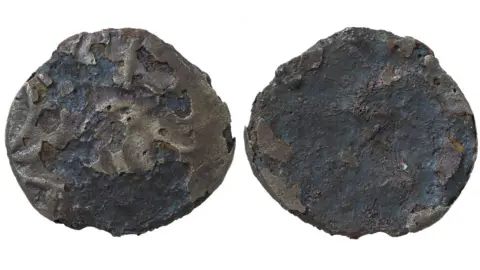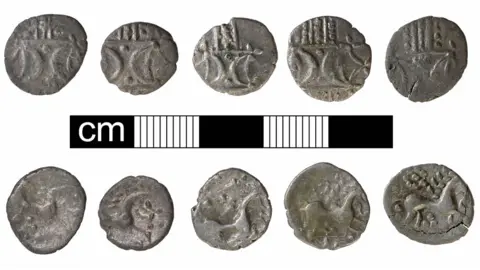Detectorist donates latest Iron Age hoard finds to Norwich museum
 Andrew Williams/Norfolk County Council
Andrew Williams/Norfolk County CouncilTwo Iron Age silver coins dating to the years before the Roman invasion have been donated to a museum.
They are part of a hoard of 25 coins discovered so far by a metal detectorist and given to the Norwich Castle Museum over several years.
Curator Tim Pestell said the donations were "amazing" and "with very, very limited funds" the museum "utterly relies on finders" to donate material.
The coins were found in a field at Stanfield, near North Elmham, Norfolk.
Dr Pestell said: "It's all about putting local finds back into the local community where they can be seen and that's why this particular donation is so well received."
 Andrew Williams/Norfolk County Council
Andrew Williams/Norfolk County CouncilThe detectorist unearthed the first 18 coins of the hoard between November 2014 and May 2015.
They are all silver units of the Iceni - the tribe best known for its queen Boudicca, who led a revolt against the Romans in about AD60.
As the coins date to between 10BC and the Roman invasion of AD43, they may have been hidden in the wake of that revolt.
 Andrew Williams/Norfolk County Council
Andrew Williams/Norfolk County Council
Metal detecting and the law
- No search can begin until permission has been given by the landowner
- All finds belong to the landowner
- Any find in England, Wales and Northern Ireland that is more than 300 years old, made of gold or silver, or found with gold or silver artefacts, could be deemed treasure under the 1996 Treasure Act
- These must be reported to the appropriate county finds liaison officer
Source: Portable Antiquities Scheme

Dr Pestell said: "Iron Age hoards aren't that common and we want to collect locally-found Iron Age hoards because the coins were produced and circulated within the county.
"This enables you to say something about the die and to date the coin hoards more accurately."
This compares to "mass-produced Roman and medieval coins, which are made across Europe - or in the London or Canterbury mints", he added.
 Andrew Williams/Norfolk County Council
Andrew Williams/Norfolk County CouncilThe detectorist, who wished to remain anonymous, discovered a further five coins in in 2017 and the latest two in 2018 and 2019.
All the coins have been declared treasure by a coroner.

Follow East of England news on Facebook, Instagram and X. Got a story? Email eastofenglandnews@bbc.co.uk or WhatsApp 0800 169 1830